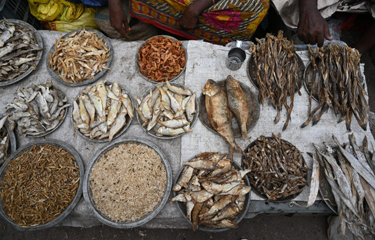The growing field of research into blue foods – aquatic animals, plants, and algae from either marine or freshwater ecosystems – and their importance to a sustainable food system is providing the seafood industry and retailers an opportunity to differentiate seafood in the broader protein market.
The Blue Food Assessment is an effort led by Stanford University’s Center for Ocean Solutions and Center on Food Security and the Environment; the Stockholm Resilience Centre at Stockholm University; and EAT, a nonprofit dedicated to food-system transformation. The initiative is intended to understand the role of blue foods in global food systems and propel change that will shape the future of the seafood industry.
“Blue foods play a central role in food and nutrition security for billions of people and are a cornerstone of the livelihoods, economies, and cultures of many coastal communities, yet they are often left out of food system analyses, discussions, and decisions,” Michelle Tigchelaar, a research scientist with Stanford University’s Center for Ocean Solutions, said. “The BFA therefore has two main goals. The first is to fill gaps in our understanding of how blue foods contribute to the food system now and in the future. The second is to provide this new information to decision-makers whose policies and actions can steer the future of the food system in a more sustainable and healthful direction.”
The groups recently published “The Blue Food Assessment,” a report investigating the importance of increasing the share of blue food in the global protein markets traditionally dominated by land-based protein sources. Accompanying the report, the BFA has produced two briefs for seafood companies and food retailers, intended to be resources for blue food markets. They include recommendations for actions to be taken by seafood companies and retailers or foodservice companies to support the uptake of sustainable blue foods.
The combination of low-impact production and the efficient delivery of a healthy, nutrient-dense protein also aligns with consumer trends for proteins giving food retailers an opportunity to expand the market for sustainable blue foods.
As governments look for new ways to address climate change, seafood provides an ideal tool to reduce the impact of food systems, as agriculture is a major driver of climate change, the according to the Blue Foods Assessment found.
“As the sector continues to grow, we will need to consider the sustainability of blue foods in terms of both their susceptibility to environmental change and their impact on the environment,” Tigchelaar said. “Blue foods are diverse, and these impacts and their implications for the sector are equally diverse. For example, climate change impacts on blue foods will vary by species, production system, and region, but are projected to be particularly severe for marine and freshwater fisheries in tropical ecosystems.”
Wild-caught fish have a lower carbon-footprint than land-based protein sources such as chicken, beef, and pork, and seafood produced from aquaculture has a carbon fooprint similar to chicken, which is one of the most efficient land-based source of animal protein. The report found that current emissions associated with aquaculture can be reduced by as much as half by reducing the use of feed and switching to deforestation-free inputs.
“Research from the BFA investigated several different impacts of food production and compared them to the commonly consumed land-based ‘benchmark’ protein of chicken. Greenhouse gas emissions from farmed bivalves or seaweed and wild-caught small pelagics have much lower emissions than the ’benchmark’ protein chicken, while wild-caught crustaceans or flatfish as well as farmed diadromous fish and tilapia tend to be much higher,” Zach Koehn, an early career fellow with Stanford University’s Center for Ocean Solutions, said. “Innovations in production can reduce these impacts, including improved feed for farmed species and optimizing fishing gear and fisheries management for captured species.”
“When thinking about the growth of blue foods in the broader protein market, it’s also important to think about health. Most blue foods are more nutrient rich than terrestrial animals, but diversity matters. While small and large pelagic fish as well as bivalves are much more nutrient rich than terrestrial animals, other blue foods including crustaceans and cod have nutrient richness values similar to, or lower than, some terrestrial animals. As the sector grows, we will need to consider the diversity of blue foods with respect to environmental impact and nutrient richness together. These BFA insights will help to prioritize interventions and innovations in the broader protein market to catalyze transformational change and increase the blue food sector’s contribution to a healthier and more sustainable food system,” Koehn said.
Koehn also highlighted the health benefits of blue foods. Because blue foods are dense in protein and include a variety of other essential nutrients, they support food security by limiting the amount of supplemental inputs communities need for healthy diets – especially for coastal communities that have little access to diverse diets. These nutrients occur in greater numbers in blue foods than the traditional land-based protein sources. Encouraging healthy eating habits that include ample blue foods can also reduce diet-caused/related diseases and illnesses globally, Koehn said.
The two-page briefs being offered by the BFA to the seafood industry provide seafood companies and retailers with a concise set of key facts and findings and a set of recommendations for action to address environmental threats to and social injustices in the blue foods industry, according to Jim Leape, the co-director of Stanford University’s Center for Ocean Solutions and a senior fellow at the Stanford Woods Institute for the Environment.
“Seafood companies and retailers bring blue foods to consumers, and play a critical role in ensuring that consumers have good choices. In the future, we will work with initiatives like the newly established to help companies develop healthier and more sustainable blue food value chains,” he said.
The briefs highlight challenges to the blue foods industry including those caused by the industry – overfishing and excessive use of antibiotics and freshwater in aquaculture, and negative impacts on the industry like ocean acidification, sea level rise, and other impacts of climate change. And they provide a list of actions seafood companies can take to improve the sustainability and marketability of their blue food options, including securing a third-party certification for sustainability of aquaculture and wild-caught species to assure best practices. The assessment suggests seafood companies could better serve the blue food marketplace by expanding production to cover a larger array of nutrient-rich species, giving commonly targeted species time to recover, and providing a large array of products for consumers to implement blue foods into their diets. It also suggests reducing food loss and waste during production and processing.
The briefs also suggest actions enabling the seafood industry to differentiate itself in the marketplace through major social change. Human rights, fair labor, and social justice challenges are prevalent in many sectors of the blue food industry and the briefs provide methods for seafood companies to address these issues. The briefs highlight three main areas of risk and concern: neglect of small-scale producers, gender inequality, and erasure of indigenous peoples. Small-scale producers are often neglected by policymakers and markets, though they account for 90 percent of jobs in fisheries, the report found. Investments by large companies in cooperatives of small-scale producers are an important step for the industry to take, it said.
The briefs also point to access to benefits, influence, and voice as unequal between genders, although roughly an equal number of men and women are employed in the seafood industry. Similarly, the voice of indigenous peoples and the traditional practices, knowledge, and rights of indigenous fishers are often undermined or overlooked. The briefs propose the industry make stronger commitments to human rights and implementation of supply-chain transparency to hold suppliers and market partners responsible for improving social practices. They also recommend third-party certifications for social responsibility, thereby allowing consumers to make choices to support socially just companies.
Photo courtesy of Blue Foods Assessment







